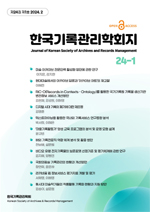라키비움 형식의 기관 소장 자료에 관한 분류체계 개발 및 온라인 서비스 방안
Development of Classification System and Online Service Methods for Collections in Larchiveum-Type Institutions: The Case of the National Memorial of the Korean Provisional Government
- 80

본 연구에서는 국립대한민국임시정부기념관이 ‘라키비움’으로서, 다양한 형태의 자료들을 포괄하여 통합 분류할 수 있는 분류체계를 고안하고, 이를 온라인 서비스하는 방안을 제안하고자 하였다. 이를 위해 사례연구로는 임시정부 자료 소장기관인 국가기록원, 국회기록보존소, 국사편찬위원회 전자사료관의 분류체계 구조 및 내용에 대해 알아보았고, 온라인 서비스와 관련해서는 위 세 개 기관과 함께 임페리얼 전쟁 박물관과 스탠포드대학교 후버연구소 도서관과 아카이브를 살펴보았다. 국내외 기관 사례분석에서 도출된 시사점을 통해, 기관 소장 자료에 대해 출처별 계층분류로 기본적인 체계를 구성하였고, ‘형태별, 시대별, 주제별’ 분류기준에 따른 다중분류체계를 제시하였다. 더불어 고안한 분류체계 개발안을 온라인 서비스에 어떻게 적용할 것인가에 대해서도 함께 제안하였다.
In this study, considering the National Memorial of the Korean Provisional Government as a “Larchiveum,” the researchers attempted to develop a classification system that can comprehensively categorize various types of materials and propose a method of providing an online service. To this end, as a case study, the researchers examined the classification system structure and contents of the National Archives of Korea, National Assembly Archives, and Archives of Korean History of the National Institute of Korean History, which are the current material collection institutions of the Korean Provisional Government. Regarding online services, apart from the three institutions above, the Imperial War Museum and the Hoover Institution at Stanford University were also explored. Through the implications derived from the case analysis of domestic and foreign institutions, a basic hierarchical classification system by provenance for the materials held by the institution was established, and a multi-classification system was presented according to the classification criteria of “by type, by era, and by subject.” In addition, methods of applying the developed classification system to online services were proposed.
1. 서론
2. 다중(패싯)분류 및 분류체계 개발
3. 국립대한민국임시정부기념관 현황
4. 통합형 기록물 수집기관의 분류체계 및 온라인 서비스
5. 임시정부 기록 분류체계 개발 및 온라인 서비스 방안
6. 결론
참고문헌
(0)
(0)